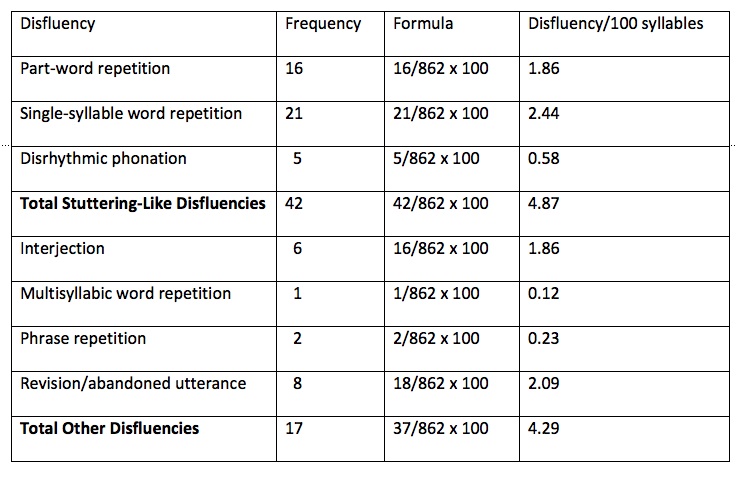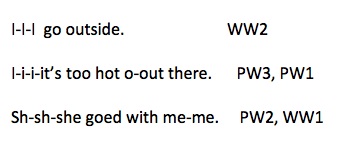By the Numbers: Disfluency Analysis for Preschool Children Who Stutter
 |
About the presenter: Jean Sawyer, Ph.D., CCC-SLP is an assistant professor in Communication Sciences and Disorders at Illinois State University. Dr. Sawyer teaches graduate and undergraduate courses in fluency and counseling, and has developed two online courses devoted to working with preschool and school-age children who stutter. She serves as co-chapter leader of a local group of the National Stuttering Association. Her research is in clinical measures of stuttering, the distribution of disfluencies in stuttered speech, and treatment of stuttering in preschool children. |
By the Numbers: Disfluency Analysis for Preschool Children who Stutter
by Jean Sawyer
from Illinois, USA
Most students in the fluency classes I teach raise their hand if I ask them if they have ever heard someone stutter, or if they think they could identify stuttering. When I ask them to describe what stuttering is, however, their response is similar to those scholars in the field who have tried to define stuttering: they are not able to come to a consensus. Several factors come into play in deciding whether speech is stuttered. Perhaps for some it is a certain degree of tension or struggle, a particular type of disfluency, the experience of the speaker or listener, or even a change in speech rate. The lack of unambiguous criteria to identify stuttered speech has led to discrepancies in how the surface features of the disorder are measured.
COUNTING STUTTERING OR COUNTING DISFLUENCIES
Efforts to quantify stuttered speech have generally involved two different directions. The first relies on the categorical judgment of disfluent events as stuttered or not stuttered, for example, the number of stuttered words per 100 words or syllables (Conture & Caruso, 1987; Riley, 1980). This type of macro analysis of speech dates back to the 1930s, when Wendell Johnson and his associates were counting "moments of stuttering," based upon the judgments of the speaker and/or listener (Johnson, 1955; Johnson & Associates, 1959; Johnson & Knott, 1936). One of the weaknesses of this approach is the considerable level of listener disagreement of what is perceived as stuttering (Cordes & Ingham, 1994a; Costello & Ingham, 1984; Curlee, 1981; Martin & Haroldson, 1981; Young, 1984).
The second approach to quantifying stuttering is a descriptive analysis, which involves identification of a priori defined speech characteristics, or disfluencies. Advantages of counting disfluencies are that it eliminates the demand of making perceptual judgments of stuttering, and allows comparisons of the speech of people who stutter and those who do not. As early as the 1930s, disfluency types were used to describe the speech of normally fluent children (Davis, 1939). Johnson and Associates (1959) used the following categories to describe disfluent speech: interjections, part-word repetitions, whole-word repetitions, phrase repetitions, revisions, incomplete phrases, broken words, and prolonged sounds.
From the range of disfluencies described, there were several attempts to delineate those types more common in the speech production of people who stutter and the ones that most frequently lead to listener perceptions of stuttering. Wingate (1964), in his famous definition of stuttering, relied heavily on the use of discrete disfluency types as a means to define stuttering, focusing on involuntary repetitions or prolongations of sounds, syllables, and one-syllable words as the core behavior of stuttering.
Disfluency analysis has been criticized in part because there have been several different schema of disfluencies described (Einarsdottir & Ingham, 2005). Some of the taxonomies include "stutter-type" and "normal-type" disfluencies (Meyers, 1986), "within-word" and "between-word" disfluencies (Conture, 1982, 1990), "typical" and "atypical" disfluencies (Gregory & Hill, 1993), and "stuttering-like" and "other" disfluencies (Yairi & Ambrose, 1992). Ingham and Bothe (2001) have argued that because not all disfluencies are stuttered, that measures of stuttering, rather than disfluencies, are more appropriate to measure the stuttering disorder. Additionally, disfluency analysis is time-consuming (Bothe, 2008).
Reliability of judgments of stuttering and disfluencies is another issue, and considerable disagreement using both methods has been reported by several investigators (Cordes, Ingham, Frank, & Ingham, 1992; Costello & Ingham, 1984; Ham, 1989; Kully & Boberg, 1988; Young, 1984). Reliability among listeners, and within the same clinic, has been reported to be higher than between listeners or between clinics (Kully & Boberg, 1988). A comparison of reliability between judgments of stuttering and judgments of stuttering has been mixed; Bothe (2008) reported higher interjudge reliability with stuttering than disfluency counts, and Hubbard (1988) found no significant differences between frequencies of stuttering and disfluency counts.
High levels of agreement for overall stuttering counts have been found in some studies, especially when stuttering was counted in terms of 5-second intervals of speech, rather than on individual occurrences (Bothe, 2008). Judges given feedback and training as to what constituted stuttering has been shown to improve reliability (Cordes & Ingham, 1994b, 1996), leading for calls to develop a set of training exemplars of stuttered speech (Bothe, 2008; Einarsdottir & Ingham, 2005).
ADVANTAGES OF USING DISFLUENCY ANALYSIS WITH PRESCHOOL CHILDREN
For the preschool child, using disfluency analysis, rather than stuttering counts, to measure disfluent speech has several advantages. One benefit is that data from the analysis can be used to compare children to the normative data provided by the Illinois studies. The Illinois studies, which have given a most comprehensive picture of the course of early stuttering, used disfluency analysis to show changes in the disorder over time (Yairi & Ambrose, 2005).
A second advantage is that disfluency analysis can help differentiate children who stutter from normally fluent children. Yairi and Ambrose (2005) have developed a set of criteria that can be used to differentiate mild stuttering from normal disfluency, using disfluency analysis (see page 338). Disfluency analysis yields data on repetition units, and Ambrose and Yairi (1995) found that the mean number of repetitions close to the onset of stuttering was more than 1.5 units. Children who are normally fluent repeat approximately once, and rarely repeat twice. Additionally, disfluencies in proximity to each other, clusters, have been shown to differentiate children who stutter from normally fluent children (Hubbard & Yairi, 1988; LaSalle & Conture, 1995; Sawyer & Yairi, in press).
Disfluency analysis can also be used in making prognoses for young children. It is true that close to onset, disfluencies cannot differentiate children who will develop chronic stuttering from those who will recover, but a downward trend in stuttering-like disfluencies over the first year of stuttering is seen as a "strong sign for eventual recovery" (Yairi & Seery, 2011, p. 364).
PREPARING A TRANSCRIPT OR TALLYING DISFLUENCIES
Disfluency analysis involves coding each type of disfluency the child has produced. Transcribing the child's speech verbatim, a time-consuming process, makes the coding easier, but it is also possible to do a disfluency analysis without a transcript, such as in the case of using a coded grid for online, real time analysis (Yaruss, 1998; Yaruss, Max, Newman, & Campbell, 1998). For research purposes, transcription is essential, but for clinical analyses, off-line disfluency analysis can be made using a tally sheet and working from good quality audio recordings. Note that to date, there have not been reliability studies done for off-line disfluency analyses done without transcripts. In an analysis using transcripts, the clinician is listening for a disfluency and typing the word and a code on the transcript. Yairi and Seery (2011) recommend typing the words of the child only and then re-listening to add disfluencies. The clinician may use a computer program such as the Systematic Analysis of Language Transcripts (Miller & Chapman, 1996) to facilitate counting. If the clinician is using an off-line procedure, he or she is listening for a disfluency and making a mark on a tally sheet. In both off-line tallies and transcript methods, total counts are made, and disfluencies are expressed as a percentage per total syllables or total words.
DISFLUENCY TYPES
The disfluencies described by Yairi and Ambrose (1992) include those more typical of stuttered speech, stuttering-like disfluencies (SLD). These include part-word repetitions, single-syllable word repetitions, and disrhythmic phonation, which are sound prolongations and blocks. Other disfluencies, which typify the speech of those who do not stutter, include interjections, multisyllabic word repetitions and phrase repetitions, revisions, and abandoned utterances. Following are examples of these disfluencies, and how they might be coded on a transcript :

Note that in the coding, for repetitions (utterances 1 and 2 above), counts of repeated units are made to calculate the mean number of times the child repeats. If there is more than one disfluency on a word (a disfluency cluster), each disfluency should be coded. So, for example, if a child says "d-d-d-----dog dog is big," the part-word repetition, prolongation, and single-syllable word repetition would all be coded ([PW3] [DP] [WW1] DOG IS BIG).
If a transcript is not made, clinicians can listen to the speech on a good quality audio recording, play and replay the audio as often as needed, and tally the disfluencies as they are heard. A sample tally sheet follows, with the first line of disfluencies tallied as an example:

The units at the bottom of the example are used to tally the units of repetition. For example, if a child said "S-s-s-see the duck," the clinician would make 1 tally mark under "PW" to indicate 1 instance of part-word repetition and 3 marks under "PW units" to indicate 3 units of repetition.
SYLLABLE COUNTS
After all disfluencies are coded, they are totaled and syllable or word counts are made. Syllable counts may be preferable with preschool children, as their use of multisyllabic words changes with age (Miller, 1981), and word counts may inflate the frequency of disfluency (Yairi, 1997). Generally, disfluencies are not part of the syllable counts, so repeated units and interjections are not counted. Words in a revision are counted, however. So, for example "I ride my bike-scooter" has 6 syllables, "I go-I go to the store" has 5, and "S-s-s-see the duck," has 3 syllables. Unintelligible words and utterances that are not usually stuttered, such as singing, and single instances of "yes" and "no" are not counted (See Yairi and Seery, 2011, for further discussion of syllable counts). If a transcript is made, syllable counts can be written in front of each utterance, and totaled at the end of the page. If a transcript is not made, using an inexpensive calculator or the calculator function on the computer as a counter is helpful. In either case, clinicians can enter the number 1, hit "enter," and then hit the equal sign for each syllable heard, being careful not to count repeated units, interjections, or words/phrases not likely to be stuttered as syllables.
DISFLUENCY COUNTS AND REPETITIONS UNITS
After syllables are counted and disfluencies totaled, the number of disfluencies per 100 syllables can be calculated by dividing the total disfluencies by the number of syllables and multiplying by 100. The following example is a disfluency count for a speech sample of 862 syllables:

The final step in a disfluency analysis is to calculate the average number of repetitions in single-syllable words and part-word repetitions. Clinicians can do this by totaling all the units of repetition in the speech sample and dividing them by the total instances of repetition in the sample. Following is an example of three utterances with type of disfluency and the number of repetition units following:

In the three utterances, the child had 5 instances of disfluencies (two single-syllable word repetitions and three part-word repetitions) and a total of 9 units of repetition. For this short sample, then, the average number of repetitions is 9/5, or 1.8.
A disfluency analysis can form part of an assessment of stuttering severity. The Illinois Clinician Stuttering Severity Scale (Yairi & Ambrose, 2005, page 32) includes disfluency counts and repetition units, in addition to levels of tension and secondary characteristics, as components used to assess severity.
Disfluency analysis can be used to help determine if a child is stuttering, is a part of the assessment of stuttering severity, and is a way to quantify changes in a child's speech over time. Disfluency analysis may be more time-consuming than analysis of stuttering, but it does provide a fine-grained description of what the child is doing with his or her speech. Knowing how stuttering-like disfluencies change over time can aid the clinician in making prognoses and treatment decisions in preschool children who stutter.
REFERENCES
Ambrose, N., & Yairi, E. (1995). The role of repetition units in the differential diagnosis of early childhood incipient stuttering. American Journal of Speech and Language Pathology, 4, 82-88.
Bothe, A. K. (2008). Identification of children's stuttered and nonstuttered speech by highly experienced judges; Binary judgments and comparisons with disfluency-types definitions. Journal of Speech, Language, and Hearing Research, 51, 867-878.
Conture, E. (1982). Stuttering (1st ed). Englewood Cliffs, NJ: Prentice-Hall.
Conture, E. (1990). Stuttering (2nd ed). Englewood Cliffs, NJ: Prentice-Hall.
Conture, E. & Caruso, A. (1987). Assessment and diagnosis of childhood disfluency. In L. Rustin, H. Purser, & D. Rowley, (Eds.), Progress in the treatment of fluency disorders (pp. 57-82). London: Taylor and Francis.
Cordes, A. K., & Ingham, R. J. (1994a). The reliability of observational data: II. Issues in the identification and measurement of stuttering events. Journal of Speech and Hearing Research, 37, 279-294.
Cordes, A. K., & Ingham, R. J. (1994b). Time-interval measurement of stuttering: Effects of training with highly agreed or poorly agreed exemplars. Journal of Speech and Hearing Research, 37, 1295-1307.
Cordes, A. K., & Ingham, R. J. (1996). Disfluency types and stuttering measurement: A necessary connection? Journal of Speech and Hearing Research, 39, 402-405.
Cordes, A. K,. Ingham, R. J., Frank, P., & Ingham, J. C. (1992). Time-interval analysis of interjudge and intrajudge agreement for stuttering even judgments. Journal of Speech and Hearing Research, 35, 483-494.
Costello, J. M., & Ingham, R.J. (1984). Assessment strategies for stuttering. In Curlee, R. F. & Perkins, W. H. (Eds.), The nature and treatment of stuttering: New directions (p. 303-334). Boston: College Hill.
Curlee, R. F. (1981). Observer agreement on disfluency and stuttering. Journal of Speech and Hearing Research, 24, 595-600.
Davis, D. M. (1939). The relation of repetitions in the speech of young children to certain measures of language maturity and situational factors: Part I. Journal of Speech Disorders, 4, 303-318.
Einarsdottir, J., & Ingham, R. J. (2005). Have disfluency-type measures contributed to the understanding and treatment of developmental stuttering? American Journal of Speech- Language Pathology, 14, 260-273.
Gregory, H., & Hill, D. (1993). Differential evaluation-differential therapy for stuttering children In R. F. Curlee (Ed.), Stuttering and related disorders of fluency (pp. 23-44). New York: Thieme.
Ham, R. E. (1989). What are we measuring? Journal of Fluency Disorders, 14, 231-243.
Hubbard, C. (1998). Reliability of judgments of stuttering and disfluency in young children's speech. Journal of Communication Disorders, 31, 245-260.
Hubbard, C., & Yairi, E. (1988). Clustering of disfluencies in the speech of stuttering and nonstuttering preschool children. Journal of Speech and Hearing Research, 31, 228-233.
Ingham, R. J., & Bothe, A. (2001). Recovery from early stuttering: Additional issues within the Onslow & Packman-Yairi & Ambrose (1999) exchange [Letter to the editor]. Journal of Speech, Language, and Hearing Research, 44, 862-867.
Johnson, W. (1955). The time, the place, and the problem. In W. Johnson & R. R. Leutenegger (Eds.), Stuttering in children and adults (pp. 3-24). Minneapolis: University of Minnesota.
Johnson, W. & Associates. (1959). The onset of stuttering. Minneapolis: University of Minnesota.
Johnson, W. & Knott, J. (1936). The moment of stutering. Journal of Genetic Psychology, 48, 475-479.
LaSalle, L. R., & Conture, E. G. (1995). Disfluency clusters of children who stutter: Relation of stutterings to self-repairs. Journal of Speech and Hearing Research, 38, 965-977.
Miller, J. (1981). Assessing language production in children: Experimental procedures. Austin, TX: Pro-Ed.
Miller, J., & Chapman, R. (1996). SALT: Systematic Analysis of Language Transcripts. Madison: University of Wisconsin.
Riley, G. (1980). Stuttering Severity Instrument for Children and Adults (Rev. ed.). Austin, TX: Pro-Ed.
Kully, D., & Boberg, E. (1988). An investigation of inter-clinic agreement in the identification of fluent and stuttered syllables. Journal of Fluency Disorders, 13, 309-318.
Martin, R. R. & Haroldson, S. K. (1981). Stuttering identification: Standard definition and moment of stuttering. Journal of Speech and Hearing Research, 46, 59-63.
. Meyers, S. (1986). Qualitative and quantitative differences and patterns of variability in disfluencies emitted by preschool stutterers and nonstutterers during dyadic conversations. Journal of Fluency Disorders, 11, 293-306.
Miller, J., & Chapman, R. (1996). SALT: Systematic Analysis of Language Transcripts. Madison: University of Wisconsin.
Sawyer, J., & Yairi, E. (in press). Characteristics of disfluency clusters over time in preschool children who stutter. Journal of Speech, Language, and Hearing Research.
Smith, A., & Kelly, E.M. (1997). Stuttering: A dynamic, multifactorial model. In R.F. Curlee & G.M. Siegel (Eds.), Nature and treatment of stuttering: New directions. (2nd ed., pp. 204- 217). Boston: Allyn & Bacon.
Wingate, M. E. (1964). A standard definition of stutering. Journal of Speech and Hearing Disorders, 29, 484-489.
Yairi, E. (1997). Disfluency characteristics of childhood stuttering. In R. F. Curlee & G. M. Siegel (Eds.), Nature and treatment of stuttering: New directions (2nd ed., pp. 49-78). Needham Heights, MA: Allyn and Bacon.
Yairi, E., & Ambrose, N. (1992). A longitudinal study of stuttering in young children: A preliminary report. Journal of Speech and Hearing Research, 35, 755-760.
Yairi, E., & Ambrose, N. G. (2005). Early childhood stuttering. Austin, TX: Pro-Ed.
Yairi, E., & Seery, C. H. (2011). Stuttering: Foundations and clinical applications. Upper Saddle River, NJ: Pearson.
Yaruss, J. S. (1998). Real-time analysis of speech fluency: Procedures and reliability training. American Journal of Speech-Language Pathology 7, 25-37.
Yaruss, J. S., Max, M., Newman, R., & Campbell, J. (1998). Comparing real-time and transcript- based techniques for measuring stuttering. Journal of Fluency Disorders, 23, 137-151.
Young, M. (1984). Identification of stutterers and stuttering. R. Curlee & W. Perkins (Eds.), Nature and treatment of stuttering: New directions (pp. 13-30). San Diego: College Hill.

